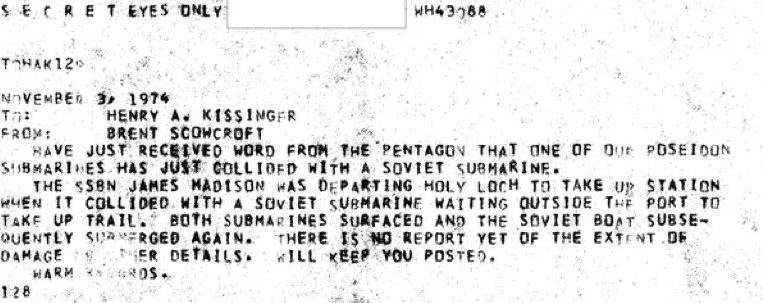
Two nuclear submarines from rival sides in the cold war collided a few miles off the coast of Scotland in an incident that was covered up for 43 years.
The potentially catastrophic crash occurred in November 1974 when the SSBN James Madison, armed with 16 Poseidon nuclear missiles, was heading out of the US naval base at Holy Loch, 30 miles north-west of Glasgow.
Soon after leaving the port it hit an unidentified Soviet submarine that had been sent to tail it, according to a cable to then US secretary of state Henry Kissinger, marked "secret eyes only".
The cable, sent by national security adviser Brent Scowcroft, said:
"Have just received word from the Pentagon that one of our Poseidon submarines has just collided with a Soviet submarine.The cable was published by the CIA on 17 January as part of a mass release of more than 12m pages of previously classified reports in 930,000 documents.
"The SSBN James Madison was departing Holy Loch to take up station when it collided with a Soviet submarine waiting outside the port to take up trail.
"Both submarines surfaced and the Soviet boat subsequently submerged again. There is no report yet of the extent of damage. Will keep you posted."
The cable corroborates an until-now unconfirmed report on the incident in the Washington Post on 1 January 1975 by the investigative journalist Jack Anderson.
He reported that the collision left a 9ft scratch on the side of the James Madison and that the two submarines came within inches of sinking one another.
Another document marked "top secret" [pdf] released in the same batch expressed alarm that the news of the collision had leaked. It said:
"On 3 January, the NID [National Intelligence Daily] ran an item on the collision just off Holy Loch of US Polaris submarine and a Soviet attack submarine. Unfortunately, Jack Anderson had run the same news in the Washington Post a day or two earlier.The last sentence of the report is thought to refer to Warner Wolf, a famous TV sports broadcaster of the time.
"This pre-emption on Anderson's part forced the surfacing (no pun intended) of a piece of information in a current intelligence 2 months after the event occurred. This deserves a Warner Wolfe 'Boo'."
Kate Hudson, general secretary of the Campaign for Nuclear Disarmament, said the secret cable exposed the "enormous risks" of nuclear weapons.
"The history of nuclear weapons is a history of near misses, accidents, potential catastrophes and cover-ups. This latest example joins 25 other near misses that could have led to nuclear war."CND is calling for an inquiry into Trident, the successor to the Poseidon programme, after it emerged that a malfunctioning missile with the potential to carry a nuclear warhead was forced to self-destruct in mid-air off the US coast last June.
Hudson added:
"These enormous risks have to be acknowledged particularly when we also now face the increasing likelihood of cyber-attack on nuclear weapons systems. With advancing technological developments added to the already dangerous mix there can be no confidence that nuclear weapons are a credible part of British security in the 21st century.Brendan O'Hara MP, the SNP defence spokesman, said the disclosure was "deeply worrying". He added:
"This is also the week of the Trident missile crisis, a misfire and a government cover-up. We shouldn't have to wait 40 years for the CIA to release documents to know the truth, which is why we're calling for a Trident inquiry."
"What happened in 1974 looks like a very, very lucky escape - it could have been completely devastating.James Jinks, who with Peter Hennessy wrote a history of Royal Navy submarines, said the cable was further confirmation of a "highly secret underwater game of cat and mouse". He said:
"The truth is - as we saw with the Trident malfunction revelations - nothing has changed, it could happen again.
"The people of Scotland live in the shadow of this appalling nuclear arsenal because Westminster puts it there - against the [wishes of the] vast majority of its elected representatives - and without taking the necessary measures to defend it or to protect the people who live here."
"The Soviets routinely sent submarines to waters around Scotland, where they would attempt to detect, track and trail Royal Navy and US Navy ballistic missile-carrying submarines as they deployed from the Royal Navybase at Faslane and the US Navy base at Holy Loch.
"A little under two years before the collision between an unidentified Soviet submarine and USS James Madison, another Soviet submarine, a nuclear-powered Victor class submarine, was detected in the Clyde-approach areas.
"For six days, the Soviet submarine remained 60 miles north-west of Donegal and 50 miles off Colonsay, where it was kept under 24-hour surveillance by RAF Nimrod maritime patrol aircraft operating out of RAF Kinloss. It was eventually 'chased out' of the area by HMS Conqueror, a Royal Navy nuclear-powered hunter-killer submarine."



Reader Comments